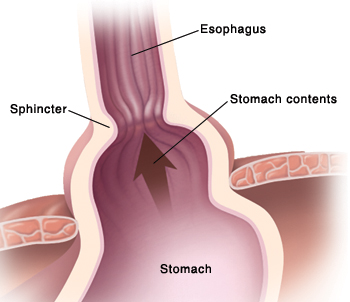Discharge Instructions: When Your Baby Spits Up or Vomits
Discharge Instructions: When Your Baby Spits Up or Vomits
At the top of the stomach is a muscle called the sphincter. When you eat, the sphincter opens to let food into the stomach. When you’re not eating, the sphincter stays closed to keep food inside the stomach. The sphincter is very relaxed in babies. It's easy for a little bit of the baby’s stomach contents to leave the stomach, travel up the esophagus (food pipe), and come out through the mouth. This is called “spitting up,” and it’s normal. But spitting up is not the same as vomiting, which can sometimes be a sign of a serious problem. This sheet will help you understand the difference.
What is spitting up?
Spitting up is sometimes called a “wet burp.” It usually happens during or right after feeding. Often only a small amount of liquid comes up. Many parents worry that a baby is spitting up most of the feeding, but usually it only looks that way. So there is no need to worry, especially if your baby is having wet diapers and growing well. If your baby spits up, gently wipe the baby’s face and lips clean. Talk with your baby's healthcare provider about what to do if your child begins to choke on his or her spit-up.
What is vomiting?
Vomiting is more serious than spitting up. It’s more forceful, and a larger amount of liquid or food comes up from the stomach. It may occur with other symptoms, such as fever or diarrhea. Vomiting can happen during or after a feeding. It can also happen when the baby isn’t eating. Vomiting can be a sign that the baby is sick (see the box below).
Signs of a problem
Call your baby's healthcare provider right away if your baby has:
Vomit that is green-tinged or red-tinged, even if the baby vomits only once
Persistent vomiting, no matter what the vomit looks like, if it seems more severe than normal spitting up
Extremely forceful vomiting that happens repeatedly
Signs of dehydration, which include dry mouth, sunken soft spot (fontanelle), listless or sleepy appearance, or no wet diapers for several hours
No weight gain or loss of weight
Updated:
January 20, 2018
Sources:
Gastroesophageal Reflux in Infants, UpToDate, Gastroesophageal Reflux: Management Guidance for the Pediatrician. J. Lightdale. Pediatrics. 2013;131(5):e1685-e1695.
Reviewed By:
Freeborn, Donna, PhD, CNM, FNP,Image reviewed by StayWell medical illustration team.,Lee, Kimberly G., MD, MSc, IBCLC
